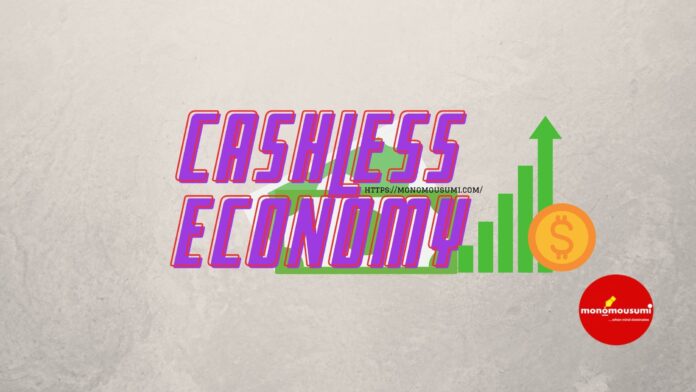Cashless Economy can be characterized as a circumstance in which the progression of money inside an economy is non-existent and all exchanges should be through electronic channels, for example, direct charge, Visas, check cards, electronic clearing, and installment frameworks, for example, Immediate Payment Service (IMPS), National Electronic Funds Transfer (NEFT) and Real-Time Gross Settlement (RTGS) in India.
For the financial year 2019-20, the expense derivation for money withdrawal surpassing 1 crore will be 2% as a piece of utilizing the idea credit only economy. Organizations with a yearly turnover of over Rs 50 crore are qualified for offer minimal effort computerized methods of installments and they will not need to cause additional charges on Merchant Discount Rate. As the advanced method of installment is surpassing the fluid money exchange strategy, the Reserve Bank of India needs to bring about less charges on keeping up the money. This at last will help in having a positive income in the economy.
Highlights of Cashless Economy in India
• Post Demonetization, the Center is making a major push for on the web
and card-based exchanges in the nation to accomplish its objective of
turning into a generally credit only economy.
• The quick development of e-installment new companies in the country.
• Launch of Unified Payments Interface (UPI) to encourage credit only
exchanges.
Cashless Economy –
There are different cashless payment modes and these are referenced beneath:
| Mobile Wallet | Plastic Money | Net Banking |
Mobile wallet: It is essentially a virtual wallet accessible on your cell phone. You can store money in your portable to make on the web or disconnected installments. Different specialist organizations offer these wallets through versatile applications, which is to be downloaded on the telephone. You can move the cash into these wallets web based utilizing credit/check card or Net banking. This implies that each time you cover a bill or make a buy online by means of the wallet, you will not need to outfit your card subtleties. You can utilize these to cover bills and make online buys.
Plastic money: It incorporates credit, debit and prepaid cards. The last can be given by banks or non-banks and it very well may be physical or virtual. These can be purchased and energized online by means of Net banking and can be utilized to make on the web or retail location (PoS) buys, even given as gift vouchers. Cards are utilized for three main roles – for pulling out cash from ATMs, making on the web installments and swiping for buys or installments at PoS terminals at dealer outlets like shops, eateries, fuel siphons and so forth
Net banking: It doesn’t include any wallet and is just a technique for online exchange of assets starting with one ledger then onto the next financial balance, Visa, or an outsider. You can do it through a PC or cell phone. Sign in to your financial balance on the web and transfer money via national electronic funds transfer (NEFT), real-time gross settlement (RTGS) or immediate payment service (IMPS), all of which come at an ostensible exchange cost.
Cashless Economy – Prepaid Payment Instrument
The RBI arranges each method of credit only asset move utilizing cards or cell phones as ‘prepaid installment instrument’. They can be given as smart cards, magnetic stripe cards, Net accounts, Net wallets, mobile accounts, mobile wallets or paper vouchers. They are characterized into four sorts:
- Open Wallets: These permit you to purchase merchandise and ventures, pull out money at ATMs or banks and move reserves. These administrations must be together dispatched in relationship with a bank. Aside from the typical dealer installments, it additionally permits you to send cash to any portable number connected with a ledger. M-Pesa by Vodafone is a model.
- Semi-Open Wallets: You can’t pull out money or get it back from these wallets. For this situation, a client needs to spend what he stacks. For instance, Airtel Money/Ola Money is a semi-open wallet, which permits you to execute with traders having an agreement with Airtel/Ola.
- Closed Wallets: This is very mainstream with web based business organizations; wherein a specific measure of cash is secured with the shipper instance of an abrogation or return of the item or gift vouchers. Flipkart and Book My Show wallets are a model.
- Semi-Closed Wallets: These wallets don’t allow money withdrawals or recovery, yet it permits you to purchase products and enterprises from recorded sellers and perform monetary administrations at recorded areas. Paytm is a model.
- Advantages of a Cashless Economy in India-
- Tackling Black Money: The principle preferred position of a credit only economy is that a record of all financial exchanges through electronic methods makes it practically difficult to support dark economies or secret business sectors that frequently demonstrate harming to public economies. This decreases the odds of dark cash entering the framework. It is additionally a lot more dangerous to go through with criminal exchanges. An economy that is generally money based encourages an uncontrolled black market which abets crimes, for example, drug dealing, illegal exploitation, psychological oppression, coercion and so on Credit only exchanges make it hard to launder cash for such evil exercises.
- Circulation of Fake Currency notes can be checked.
- A credit only economy will help lessen defilement.
- Increase Tax base: It is hard to stay away from the appropriate installment of due expenses in a credit only economy, such infringement are probably going to be enormously decreased.
- The expanded expense base would bring about more prominent income for the state and more noteworthy sum accessible to support the government assistance programs.
- Digital exchanges acquire better straightforwardness, adaptability and responsibility.
- Digital exchanges are advantageous and improve market effectiveness
- Transaction costs will descend over the long haul
- It would cut down the coordinations and cost engaged with printing, overseeing and moving cash around.
- It will wipe out the dangers related with conveying and moving enormous measures of money.
- The credit only economy will lessen the creation of paper cash and coins. This will save a ton of creation cost thus.
- A part of information move occurs because of the credit only exchange. This information will help the public authority plan for future costs, for example, lodging, energy the board, and so forth from the example of the information transmission.
Challenges in transitioning to a Cashless society-
- Acceptance infrastructure and digital inclusion: Lack of satisfactory foundation is a significant obstacle in setting up a credit only economy. Wasteful financial frameworks, poor advanced foundation, helpless web availability, absence of strong computerized installment interface and helpless entrance of PoS terminals are a portion of the issues that should be survived. Expanding cell phone entrance, boosting web availability and building a safe, consistent installments framework is an essential to progress into a credit only economy.
- Financial Inclusion – For a credit only economy to remove the essential precondition that should exist is that there ought to be general monetary incorporation. Each individual should approach banking offices and should hold a financial balance with charge/Mastercard and internet banking offices.
- Digital and Financial Literacy – Ensuring monetary and advanced incorporation alone are not adequate to progress to a credit only economy. The residents ought to likewise be made mindful of the monetary and computerized instruments accessible and how to execute utilizing them.
- Cyber Security – Digital framework is profoundly defenseless against digital assaults, digital fakes, phishing and fraud. Off late digital assaults have gotten more modern and coordinated and represents an undeniable risk. Henceforth setting up secure and tough installment interfaces is an essential for going credit only. This incorporates upgraded guards against assaults, information insurance, tending to security concerns, hearty reconnaissance to pre-empt assaults and systematized online protection engineering.
- Changing habits and attitude – Indian economy works fundamentally on money because of absence of entrance of e-installment modes, computerized ignorance of e-installment and credit only exchange techniques and thirdly propensity for dealing with money as an accommodation. In this situation, the ideal activity is to cause individuals to embrace e-installments in a steady design and spread attention to start social change in propensities and disposition.
Urban-Rural Divide – While metropolitan focuses generally appreciate high velocity web availability, semi-metropolitan and country territories are denied of a steady net association. Along these lines, despite the fact that India has in excess of 200 million cell phones, it is still some time away for provincial India to consistently execute through cell phones. Indeed, even as to the presence of ATM’s, PoS terminals and bank offices there exists a huge metropolitan rustic gap and overcoming this issue is an absolute necessity to empower a credit only economy.
- Is India Ready for a cashless economy?
India’s reliance on cash
- Indian economy is primarily to be driven by the use of cash and less than 5% of all payments happen electronically. This is to a great extent because of the absence of admittance to the proper financial framework for an enormous piece of the populace and just as money being the solitary methods accessible for some. Huge and little exchanges keep on being done through money. Indeed, even the individuals who can utilize electronic installments, use money.
- Indians generally really like to go through and set aside in money and a lion’s share of the more than 1.2 billion populace doesn’t have a ledger.
- Indian economy is basically determined by the casual area, and it depends intensely on money based exchanges.
- A report by Google India and Boston Consulting Group indicated that IN 2015 around 75% of exchanges in India were money based while in created nations like USA, Japan, France, Germany and so forth it was simply around 20-25%.
- RBI gauges for July 2016 show that banks had given around 697.2 million charge cards and 25.9 million Mastercards to clients subsequent to deducting removed or dropped cards. Notwithstanding, cards all alone can’t transform the economy into a credit only one. Note that the quantity of cards in activity isn’t equivalent to the quantity of people holding those cards. It essentially implies that numerous clients hold various records and cards.
- The difficulty in going digital is exemplified by the data on debit card usage — over 85% (in volume) and 94% (in value) of all debit card usage is at ATMs for the purpose of withdrawing cash. The chief reason for cards in an Indian setting is subsequently a way to pull out money. The outstanding development in check cards (more than 600 million) is an immediate outcome of the monetary consideration drive that prompted the launch of more than 170 million ledgers. In spite of the fact that the move put plastic cash under the control of millions, viably it has just moved money withdrawals from banks to ATMs, which was not exactly the aim.
India’s Cash to GDP ratio:
As calls for going credit only develops stronger in India, a key test being looked at the worldwide level is to check the proceeding with ascend in the absolute estimation of the money accessible for use and its proposal in the overall GDP, an example particularly found in the US, Switzerland and Euro domain. A particularly proceeding with ascend in the dissemination of monetary standards for financial exercises could well be a significant obstacle in the change to a credit only and computerized economy.
India’s cash to GDP ratio — an indicator of the amount of cash being used in the economy — is around 12 to 13%, which is much higher than major economies including the US, the UK and Euro region however beneath that of Japan (about 18%).
Amazingly Indonesia, another making economy, has a much lower extent of around 5%.
Cashless Economy and Government Initiatives
1. UPI: India’s greatest and boldest installments interface wager yet
What is UPI?
Bound together Payments Interface has been dispatched by National Payments Corporation of India (NPCI) to additional RBI’s vision of changing towards a “not so much money” but rather more computerized society. A bunch of standard application programming interfaces (APIs) give an interoperable framework to consistent exchanges, and it has been based on top of the prompt installment administration (IMPS) stage. The UPI biological system capacities with 3 central participants:
• Payment specialist co-ops (PSPs) to give the interface between the payer and the payee. In contrast to wallets, here the payer and the payee can utilize two diverse PSPs.
• Banks will give the fundamental records. Sometimes, the bank and the PSP might be the equivalent.
• NPCI will go about as the focal switch by guaranteeing Virtual Payment Address (VPA) goal, influencing credit and charge exchanges through IMPS.
How can it work?
UPI which is based on IMPS permits installment straightforwardly from your ledger progressively. There is no compelling reason to pre-load cash in your wallets. It takes into account installments to various traders and merchants without the issue of composing card subtleties or net-banking secret word. Cash moves with this interface are gotten with the two-factor verifications as commanded by the RBI: your cell phone handset establishes the primary factor and the versatile PIN is the second.
Is UPI better than cards?
UPI will acquire ease, high-volume installments and help make another biological system where clients and dealers will meet up for quicker and more straightforward electronic installments. It is probably going to profit the general installments environment, as the installments administration can be furnished by banks to the dealer with a passage level cell phone and it doesn’t need a PoS machine. Hence, it is probably going to diminish the general vendor procurement and working expense for the banks.
The main component of UPI is its open engineering. The UI is exceptionally adaptable and banks have the opportunity to make the most natural interface. The development will likewise welcome all critical partners on a typical stage and will help make a plenty of administrations that are incredible in the present worldwide installment contributions.
The accomplishment of UPI is essentially subject to the reception of the stage by all banks. Further, a client needs to have a cell phone to make an exchange and thus the potential client base will be limited to around 240 million individuals as of now.
2. NITI Aayog Committee-
• The Center has set up a panel headed by NITI Aayog CEO Amitabh Kant, to detail a system to facilitate the way toward changing India into a credit only economy.
• The board is entrusted with distinguishing different bottlenecks that are influencing admittance to advanced installments.
• The board has been approached to distinguish and operationalise in the soonest conceivable time span easy to use computerized installment choices in all areas of the economy. This is a vital segment of the public authority’s procedure to change India into a credit only economy .
• The board will connect routinely with all partners – Central services, controllers, state governments, region organization, neighborhood bodies, exchange and industry relationship to advance reception of computerized installment frameworks.
• The thought is to set up and screen an execution system with exacting courses of events to guarantee that almost 80% of the exchanges in India moves to the computerized just stage.
• The board of trustees will likewise attempt to assess the costs associated with different advanced installments alternatives and direct the usage of these measures to make such exchanges between the public authority and residents less expensive than money based exchanges.
• The Center is additionally running after moving all administration exchanges to the credit only mode, through another single-window e-installment framework that people or organizations can use to make installments to any focal or state office.
• During the primary gathering of the board of trustees, it was chosen to use existing Common Service Centers to help train dealers to utilize computerized installment strategies.
3. Panel of Chief Ministers-
• The Center has declared the setting up of a 13-part board, which incorporates 6 Chief Ministers, to concoct an activity plan to quickly extend the utilization of computerized installment stages the nation over. The board of trustees would be going by Andhra Pradesh CM Chandrababu Naidu and would likewise incorporate NITI Aayog Vice-Chairman and CEO and top names from the business and the scholarly world as extraordinary invitees.
• The terms of reference of the board incorporate recognizing worldwide prescribed procedures for actualizing an economy principally dependent on advanced installments and analyze the chance of embracing these worldwide principles in the Indian setting.
• The board will likewise diagram measures for quick extension and selection of the arrangement of computerized installments like cards (Debit, Credit and paid ahead of time), Digital-wallets/e-wallets, web banking, Unified Payments Interface (UPI), banking applications, and so forth and will extensively think of the guide to be executed in one year.
• It will solidify an activity intend to contact general society everywhere with the goal to make mindfulness and assist them with understanding the advantages of exchanging over to a computerized economy and would settle a guide for the authoritative apparatus in the States to encourage the reception of advanced methods of monetary exchanges.
• The undeniable level gathering will likewise help distinguish and clear bottlenecks and give arrangements relating to the appropriation of the means important to move towards a computerized installments economy.
• It will likewise work with all the critical partners for execution of the recommended ventures towards a computerized installments economy and depict and embrace estimates created by the Committee of Officers comprised for the reason.
4. Ratan Watal board on advanced installments
The board, headed by previous money secretary Ratan Watal, was established in August to recommend approaches to support India’s development towards a credit only economy.
Way Forward
India should gain from different nations in the creating scene, which have figured out how to decrease their reliance on money even while getting more individuals in the folds of the proper financial framework. Kenya has been an all around recorded example of overcoming adversity, where portable cash has spread a lot quicker and more profound than in India. Kenyan families with admittance to versatile cash had the option to oversee negative financial stuns (like occupation misfortune, demise of animals or issues with harvests) better than those without admittance to portable cash.
The path forward is clear:
• Put resources into building the necessary monetary and advanced framework
• A cross country monetary and computerized proficiency crusade joined by a medium-term procedure to improve admittance to, and familiarity with, electronic installments.Directed monetary instruction projects can improve monetary abilities and credit the executives, and increment account proprietorship.
• The public authority should attempt the massive errand of changing perspectives towards computerized installments among clients and traders.
• Put in place all necessary cyber security measures.
Innovative proficiency and better computerized framework will make India a monetary force to be reckoned with. The e-installments administrations and advanced exchanges are acquiring uncommon force. Activities like Digital India Campaign and support of educated residents will change the country into a credit only economy in not so distant future.
By Vaishali Mehare











